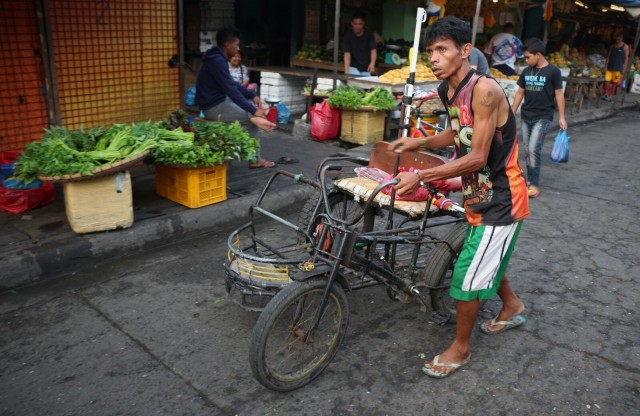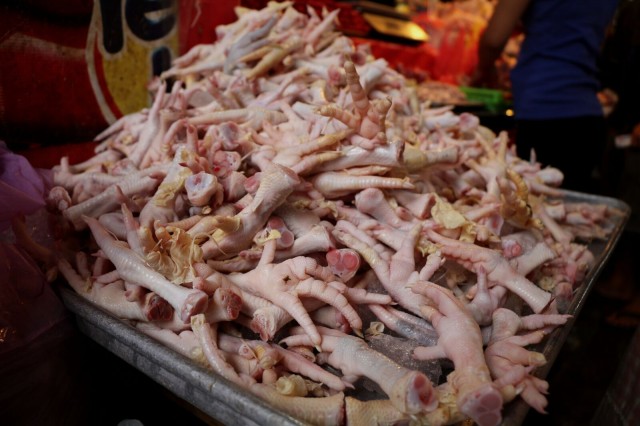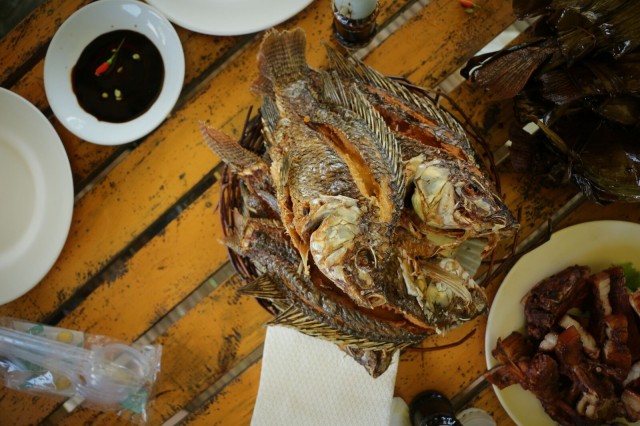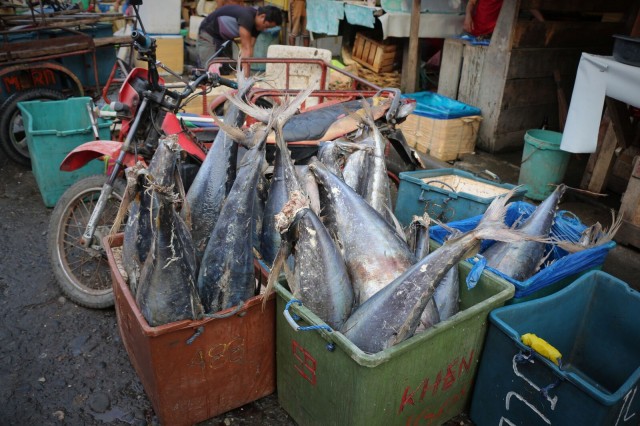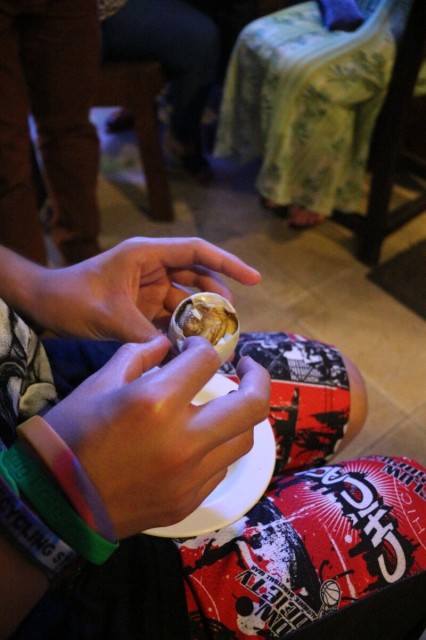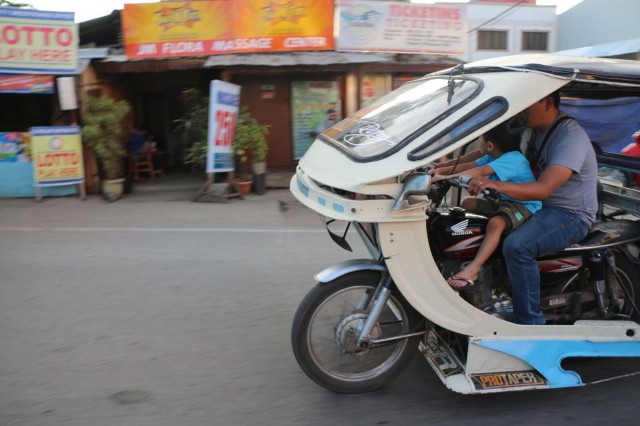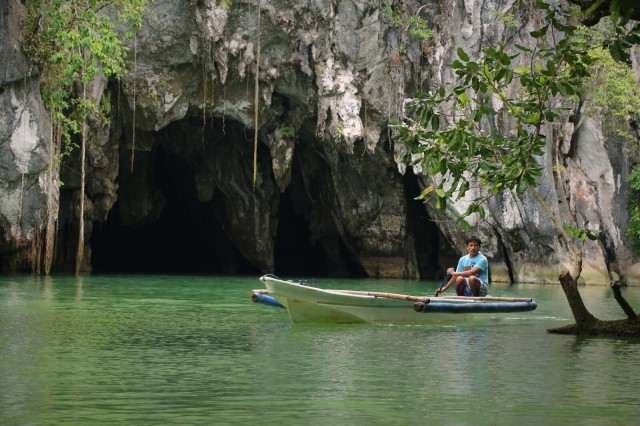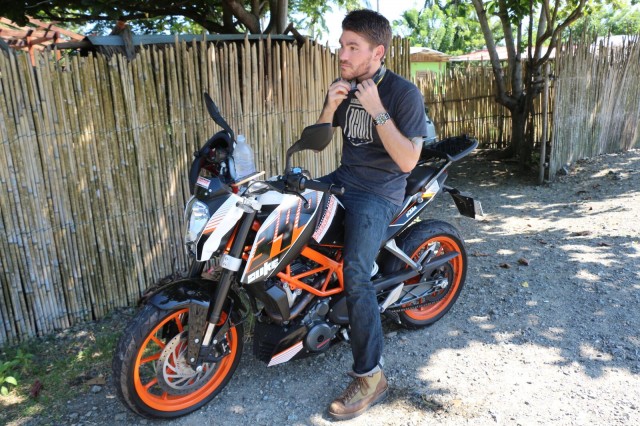It was the first night we’d slept in a few days. Really slept… like the dead. It didn’t matter that a foot above the uncovered window sat a Halogen street lamp that shone directly onto our pillows. What mattered less was the gecko that ran for its life when we pulled back the sheets that were once his home. Seven hours in the departure seating area for the cheap [read: terrifying] domestic flights were about six and a half hours too long. That morning’s trudge through a typhoon, scramble to the train, two and a half hour ride to Narita and all the connecting flights later didn’t mean anything anymore in that tuna can Manila falsely claimed to be an airport. It was a sweatbox in there, crammed shoulder to shoulder with restless bodies, strange smells and a loud ongoing buzz of chatter and cackles. We weren’t in Japan anymore. Upon all that I’ve done and seen these past months, America, my home, was a quickly fading memory. The Philippines was – finally – the official Southeast Asian adventure that we thought we’d wanted. But the dream was quickly shattered when the pride and joy of Philippine national security decided my brand new Japanese crafted chopsticks were more of a threat to their ‘frequent flyers’ than a pocket knife. It’s a long story.
The Unorthodox Vacation
If you’re looking for tropical paradise that will sweep you away from the mundane reality that is your nine-to-five, your ‘full-credit’ semester in college or your part-time job for tips, then you might as well go to Hawaii. It’s cleaner. It’s safer. There are rules, and most people obey them. The Philippines is the “Wild West” of the East… on steroids. What it lacks in order, it makes up ten-fold in color – literally and figuratively. People live within an aging class system. The vastly impoverished live amongst the Kings. Philippine settlements are stuffed with corrugated aluminum ramshackle homes, stilted bamboo shacks, concrete mansions and the occasional (dozen) skyscrapers. In the cities, billboard ads offering better food, healthcare, hair and futures glow their propaganda wherever space is available. Security guards check your belongings with a stick and post up in front of malls and ritzy hotels with fully-automatic MP4s strapped to their chests. This is a ‘third-world’ country after all, and there’s no denying it amidst the gritty streets of any major municipality or the dusty roads of a rural village.
Not scared away yet? Good. Because what the Philippines really have to offer at its core are generous, driven people with loud mouths and soft eyes. As far as I’m concerned, everyone here loves to sing. Everyone loves to dance. And when the occasion calls for it, they all love to party. Even funerals require feast, gambling and karaoke. Mini getaways, like Paradise Island, attract hoards of locals to swim in warm salt-water, eat full roasted pigs, listen to mariachi-esque bands, drink San Miguel and Buko juice, and ride dangerously choppy water on a rented Wave Runner. There’s even a really bizarre vaudeville-meets-clown-meets-retired-gymnast show. And, did I mention, Wave Runner!? It’s the motorcycle of the sea and damn it if we didn’t get loose.
Ground Control
My whole life I’ve associated a certain aroma with the Philippines, though I could never pinpoint what. It wasn’t the people – just the place. It wasn’t a clean smell, but it wasn’t unpleasant. Actually, quite the contrary. What I didn’t know then was that this smell, this memory, happened to be diesel. Because I have family in PI, public transportation has not been something I’ve had to worry about, but it’s not unfamiliar. Though Jeepneys are a dying breed, their historic value, recognized by the community, keeps them alive – barely. They have been the main method of public transportation for over half a century. Homemade tricycles are pieced together using a small displacement Japanese motorcycle encaged by a highly decorated front end of a small pickup truck. Depending on the island, you can now get around by way of a more traditional Taxi or even Uber. That said, I suggest to anyone who visits, if you have the means and the nerve, to rent some motorcycles. It shouldn’t need to be said, as with any chaotic country, but being incredibly alert on the road is essential. But, the balmy temperatures, clear mountain roads and incredible panoramas are well worth a little risk.
We’ve all seen the photo of a whole family on a scooter. Or the family, a friend, the goat, a cage of chickens, buckets covered by banana leaves, and packages filled with who knows what. It’s orthodox to see a baby wedged between their parents, gearless and curious, wincing through the wind. About 3.5 million motorcyclists were recorded in 2013, the numbers are growing, and that’s just those who are registered! Rentals can be cost efficient and safe; I just did some research, read reviews, prepared for the worst and prevented a world of hurt (or worse). Enter, rent-a-bike, the motorcycle rental company in Palawan – owned and operated by Russian expats – where we obtained a couple of KTM’s new 390 Dukes to blast through the jungle – my first time ever on a sport bike. Ankle deep in sea water amongst an underwater mangrove forest, we were caught a bit off-guard when they found us. The bikes had been delivered, and gladly too, since this was their favorite beach. The only place you can actually float between the trees.
Welcome To The Jungle
The ride back to our cottage later that night was… interesting. The sky was pitch black and moonless, the road rocky, tires slick and the bike more powerful than I had predicted. Not expecting to ride (and I won’t mention what I was wearing) added a little edge to the constant bob and weave around feral dogs, chickens and children. After we parked, Justin and I settled into the back of the Russian’s truck. There’s something raw about riding unstrapped in open air, whether on a motorbike or in the back of a pick-up. Wind blew dust into my eyes and forced diesel up my nostrils. Dim colorful lights broke through the dark blanket of night. The frenzy of traffic resolved itself throughout every sketchy moment – proof of self-reliance in the community.
I’ve done this before, ridden on the white lines trying not to be barreled over by some truck or shuttle bus. But Baja was child’s play compared to the Philippines’ obscur highways, jam-packed with motorbikes, trucks and flip-flops, and not a regulation to be found. My only real saving grace was the bike below me. In town, you can’t go more than 25 KPH without exponentially increasing the risk, which happened – often. Once we were into the mountains or along the lonely coastlines, the only real dangers were water buffalo, sharp corners and going way too fast. For days, we rode through lush jungles, sipped straws in young coconuts, avoided thieving monkeys, and found ourselves at an underground river. The best instruction we were given stepping into our Banana Boat: “When you look up (in awe) at the vastness of the cave, don’t say ‘Wow.’” Unless you want to get bat dung in your mouth. “If it’s cold and sweet, it’s ‘Holy Water,” our guide chuckled. “If it’s warm and salty, it’s ‘Holy Shit.’” This sound advice has stayed with me long after I’d left.
A Hop, Skip and a Scary Plane Ride
It was the first time I had ever been genuinely concerned that I might die on a plane. Inter-island travel is expected in a place like the Philippines, but to cut corners on airline choice just to save on cash is risky. And pointless. The amount of extra money you’ll spend on Philippine Airlines – a company which flies to the U.S. and is therefore regulated by the F.A.A. – compared to, eh hem, AirAsia, is well worth the peace of mind. For one, on the new (as opposed to the 30 year-old) Philippine Airlines Airbus, the seat belts were free of knicks, fraying and discoloration. The chairs were actually clean. And the engine flew sans cellophane. All things considered, if you plan to visit one of the 7100+ islands in the Philippines, plan to take this air-equivalent of a Marriott hotel shuttle, not a Jeepney.
It was well into the wee hours when we landed in Davao City, and my mom, cousin, nephew and their driver had been waiting patiently for hours. Mindanao can be very dark – like its most unfavorable reputation. The American government suggests we just avoid it altogether. Yes, any vulnerable foreigner foolish enough to stand out can garner unwanted attention, but that’s not limited to the Philippines. My experiences have always been pleasant, if not intriguing. I’ve never felt threatened on my strolls through the market, or ostracized when I’m the only ‘foreign’ looking person in a square mile. The people are kind, as I’ve mentioned, and desperate acts only occur when people are desperate. So it’s easy enough to avoid or surpass.
The real danger is eating Balut! Half the people I know in the PI love it, the other half make the same wrinkly “blehk” face as me when someone cracks it open and sips out the juice. Blehk! Balut is a fertile egg equipped with its own baby duck fetus… feathers, beak ‘n’ all. It’s typically hard-boiled and shoved in a bucket to dole out to eager consumers. As the lifelong joke goes, my cousins offer Justin and I a portion, every time. We declined. But this doesn’t stop them from cheerfully drowning us in beers and testing our willpower – regularly offering us this Filipino delicacy. Without distinct knowledge of what it is, I might have eaten it. But the look of it looking back at me, and my childhood memories in the kitchen can’t be unseen or un-smelled. Plus, I hear the beak could get caught in your throat, and I think – for my safety, of course – it’s just not worth the risk (I’m talking to you, cousins!).
Conclusion
Though they are trying, the country is still mostly an unknown to Westerners who fear its “terrorist” tainted reputation. It isn’t any more dangerous than Mexico… Actually it’s FAR less dangerous considering current events! With the hopes of increasing their tourism, the Philippine government – and people for that matter – goes to great lengths to keep their beaches clean, their buildings erect and their temporary citizens safe. The foreigners have it better in the Philippines than the actual Filipinos! Not that this is something to boast about, but it tells you something. Either way, it’s an unsullied series of islands that tourists haven’t managed to trample over so much that the culture has lost its authenticity. Which for some can be a setback, and for those, again, I refer back to your better suited vacation (not adventure) in Honolulu. Mahalo!
In three months we’ve flown in 14 different airplanes and over 38,000 miles (Justin has traveled over 50K!). Not much compared to the average international businessman, but it still had me thinking about numbers. Seeking adventure can be risky. And in any high stakes game, the more you take risks – theoretically – the more likely you are to lose. But maybe, I hadn’t yet taken enough to end my winning streak. I half-heartedly joked that in all their years of air-travel, a pilot could become incredibly skilled or dangerously complacent. To which Justin responded: “Pilots don’t want to die either.” And so, with that crude logic, my heartbeat slowed, palms went from sweaty to balmy, and then the plane lifted off silently – bound for Narita – while I prayed our pilot didn’t have a death wish. I’m not ready for my Filipino-style street-side funeral with rosary and feast in my honor. In a few years, I want to come back to the Philippines… alive. To visit family – teasing each other for how much we’ve aged – and maybe (finally) try Balut. To ride dangerously fast motorcycles bobbing in and out of the even more dangerous traffic. To observe the advancing cosmopolitans, and relax in the tepid bath waters lining the rural fishing towns. When I come back, I’ll be different. The Philippines will be different. And I hope the adventure will be as well.
About the Author
Kyra Sacdalan is a freelance journalist. She is the co-creator of WESTx1000, a multimedia company that creates unique content for motorcycle community. Follow her on Instagram.



